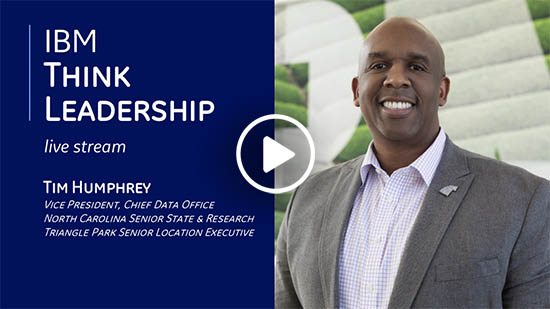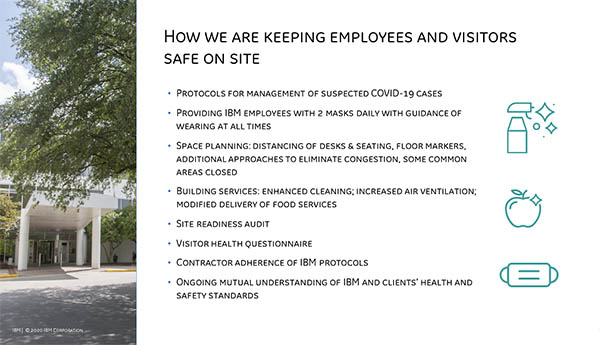IBM and Coronavirus stories
Tim Humphrey: Reimagining the Future of the Workplace

Watch a replay of Tim Humphrey's presentation
As the COVID-19 crisis moves from the triage to the transformation phase, many organizations are thinking hard about what the next phase of their businesses and workspaces will look like.
“We have to change quickly, not only to adapt but to survive,” Tim Humphrey, Vice President of IBM's Chief Data Office, said during an IBM Think Leadership livestream on May 12.
Humphrey also serves as IBM’s senior state executive for North Carolina, and as the senior location executive for the company’s largest site in North America, at Research Triangle Park, N.C. His work focuses on ensuring business continuity and the reliability of critical information as his team infuses IBM’s enterprise operations with AI and cognitive tools. From his North Carolina base, he’s also a disaster preparedness expert, having ridden out savage storms and even hurricanes in recent years.
Now Humphrey is preparing for one of the most pressing and significant decisions many executives will ever make—when and how to restart business operations and return employees to the office as the pandemic eases its grip. In this “new abnormal,” as it’s been called, companies must ponder many factors and plot out the best way to safely return employees to the workplace and ensure they are not contributing to community risk, as well.
In sharing his ideas and experiences during the livestream, Humphrey also addressed questions he has received from industry peers in recent weeks:
What are the key factors driving your decision-making about a return to the workplace?
Every decision is made with data in mind. Insights from data are 10 times more valuable than insights from intuition, which is susceptible to emotions and bias. Data is not a fad. It’s not a trend. Data is truly our new natural resource.
Our biggest concern is planning for how we can return people to the office while making sure that health and safety is the number one priority. So we have a set of criteria that includes several factors based on government guidelines, as well as tracking data and trends around the virus. We’re looking for insights from that data that give us a lot more comfort than we have today. And when we do return to the office we’ll put a number restrictions in place, like limiting the number of people in certain areas, reducing occupancy, requiring home self-screening and temperature checks, and mandating the use of facial coverings. Importantly we will have protocols in place for what we do when there is confirmed or suspected exposure to COVID-19 in the workplace because we are still susceptible to the disease

You can prepare a physical site with the proper distancing, cleaning, masks and sanitizer. But how can you get people ready for the psychological shifts that are necessary?
We’re going to be brutally honest. People need to know what to expect so they can mentally prepare for what the office will look like. We’ll even produce a video of the place so workers can create a mind’s-eye view. It’s not going to be like it was before.
Some of it may be uncomfortable, at least in the short-term. It is going to be a trade-off. There’s not going to be handshaking or sitting close together. We'll have to move desks and seats around so we eliminate congestion. We may remove conference rooms. We have to reimagine our building services. We'll have to do enhanced cleaning procedures and improve our air handling, heating, ventilation and air conditioning systems, as well as redesign the way breakfast, lunch and snacks are served. There’ll be an adjustment period. But we know that people’s ability to adapt is remarkable.
How did IBM respond to COVID-19?
One of the benefits of being a global enterprise is that we get to see in real-time what's happening in different parts of the world. So this past winter, as things began to develop and the virus started to gain steam, we activated our crisis management team.
As the virus spread and came closer, we quickly enabled work from home for anyone whose work did not require them to physically be on-site – some 95% of the company, almost overnight. We enacted many health safeguards for workers who did need to be on-site, like those employees who needed to keep our data center servers running. It’s all part of our continual focus on business continuity. You have to constantly push the boundaries of preparation. You are never done.
As everyday professionals, we're geared to starting something and then finishing it. But business continuity planning is never finished. You have to constantly ask yourself, “What if? What if? What if?”
We’ve talked about a multiphase plan to return to the office. What does that look like?
It will be a slow transition. Individual leaders will need to make a call on the timing only once all the protocols are met. IBM will have a global set of standards that will be deployed uniformly. Some teams may find they’re more productive by continuing to work from home, rather than coming back to the office. They may decide that a video conferencing tool is better than staying six feet away from everyone and the discomfort of wearing a mask all day. When some teams are trying to prepare for a particular project it may make more sense to have them together in an office for a day or two, then return to working from home.
When we look back on this crisis, what will be the biggest leadership lessons?
Invest in your people. You can do all the employee engagement activities in the world, but if a manager isn't connected to their employees and making the work environment comfortable, all of that goes out the window.
This crisis has reawakened that understanding for managers. They need to see that their peers are people too. When you connect on a personal level, it’s so much easier to work together when times are hard. You have to be a strong leader in times of crisis or change. Everyone looks to their leaders on how to respond. It's easy to be a leader in good times, but true leaders shine when times are turbulent.
→ Visit the IBM News Room's complete coverage of IBM's response to the coronavirus pandemic